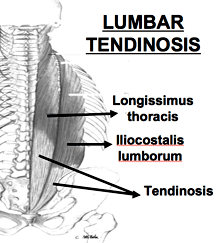 One of the chief characteristics of tendinopathy is the gradual onset of morning stiffness in the tendon.3 This morning stiffness is often found in Achilles tendinosis. Can this also be a reason for low-back morning stiffness? Tendinosis-type tissue often is nodular, which can be felt parallel to the lumbar spinouses or paraspinal areas. Clearly, much success with treating tendinosis has been achieved using mechanical-loading techniques on the paraspinal and sacral areas, such as Graston Technique, ART, friction massage, neuromuscular re-education and others. Langevin and Sherman wrote about increased connective-tissue stiffness due to fibrosis as an important link in the pathogenic mechanism leading to chronic pain.4 Changes in connective tissue surrounding the tendon and intratendinous degeneration in the body of tendons due to overuse, hyper- and hypomobility can result in either atrophy or fibrosis. Micro-injury can create inflammation, tissue hypo-oxygenation and cytokines such as TGF-1, causing fibrosis. I have several patients who see a massage therapist in Florida who literally brings them to tears working on their spinal musculature. He is extremely busy, but there is really no need to torture patients. There are excellent techniques mentioned above that are essentially painless.
One of the chief characteristics of tendinopathy is the gradual onset of morning stiffness in the tendon.3 This morning stiffness is often found in Achilles tendinosis. Can this also be a reason for low-back morning stiffness? Tendinosis-type tissue often is nodular, which can be felt parallel to the lumbar spinouses or paraspinal areas. Clearly, much success with treating tendinosis has been achieved using mechanical-loading techniques on the paraspinal and sacral areas, such as Graston Technique, ART, friction massage, neuromuscular re-education and others. Langevin and Sherman wrote about increased connective-tissue stiffness due to fibrosis as an important link in the pathogenic mechanism leading to chronic pain.4 Changes in connective tissue surrounding the tendon and intratendinous degeneration in the body of tendons due to overuse, hyper- and hypomobility can result in either atrophy or fibrosis. Micro-injury can create inflammation, tissue hypo-oxygenation and cytokines such as TGF-1, causing fibrosis. I have several patients who see a massage therapist in Florida who literally brings them to tears working on their spinal musculature. He is extremely busy, but there is really no need to torture patients. There are excellent techniques mentioned above that are essentially painless.
However, treating tendinosis is not the end-all for chronic lumbar pain, just as treating the extensor carpi radialis brevis enthesis is not all that is necessary for a tennis elbow. There is that vast subject of rehabilitation covering whole-body and joint stability/mobility, abnormal motor patterns, endurance and strength, etc.
References
- Benjamin M, Kaiser E, Milz S. Structure-function relationships in tendons: a review. J Anat 2008;212:211-28.
- Benjamin M, McGonagle D. The anatomical basis for disease localization in seronegative spondyloarthropathy at enthuses and related sites. J Anat 2001;199:503-26.
- Khan KM, Cook JL, Bonar F, Harcourt PAM. Histopathology of common tendinopathies. Update and implications for clinical management. Sports Med 1999;27:393-408.
- Longevin HM, Sherman KH. Pathophysiological model for chronic low back pain integrating connective tissue and nervous system mechanisms. Med Hypoth 2007;68(1):74-84.
Click here for previous articles by Warren Hammer, MS, DC, DABCO.





